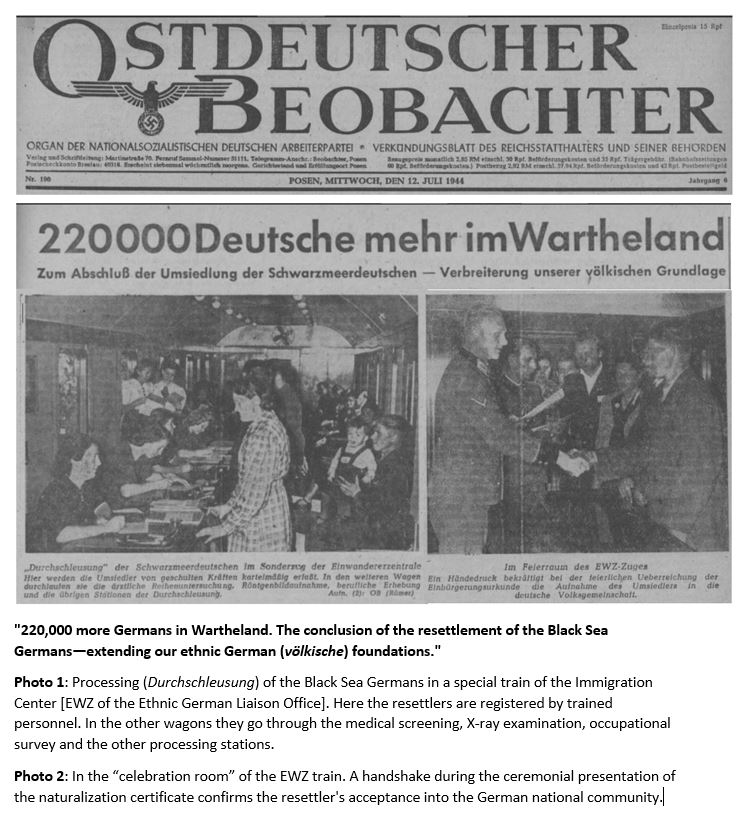They walked in one end as Soviet citizens, proceeded through a few wagons, and emerged out the other end as naturalized citizens of the German Reich.
Below is a newspaper article marking the completion of the
registration and naturalization of some 35,000 Mennonite resettlers—plus other
Black Sea Germans. By July 1944 all the treks or transports had arrived from
the Black Sea region into Greater Germany [most in Warthegau], and almost all
were now registered for a more permanent settlement situation in German-annexed
Poland—or so they thought.
The translation is important because it offers a clear
account of the process of naturalization, application and assessment. While not
all Mennonites evacuated from Ukraine 1943-44 were naturalized in one of the
visiting mobile Immigration Central Office trains, most were. The article and
photos fill a gap in our knowledge of that experience in Nazi Germany and how
naturalization was approached and experienced by some 30,000-plus Mennonites.
While previous posts (see Table of Contents) brush on aspects
of the application procedure, this newspaper account gives a concrete picture
from the era of the steps taken (literally), and the celebrative atmosphere of the
occasion. While the article is a general propaganda piece, it calls into
question post-war claims that Mennonites were coerced to take on German
citizenship (see Table of Contents for related posts).
---Arnold Neufeldt-Fast
Source: Ostdeutscher Beobachter 4, no. 190 [July 12, 1944],
3, https://www.wbc.poznan.pl/dlibra/publication/126128/edition/135300/content.
“... The resettlement of the Russian Germans from the East,
which began in September last year as part of the withdrawal of the German
front, has essentially been completed. Around 350,000 people were, in the long
run, in danger of losing their intrinsic Germanhood due to the alien nature of Bolshevik
dictatorship. They have now been saved and are being brought into a new, more
meaningful call within the protective borders of the Reich. According to a
promise [made in Halbstadt] from the Reichsführer SS and Reich Commissioner for
the Consolidation of the German Nationality, Heinrich Himmler, after a
transitional period—which at the same time serves their acclimatization to the
changed living and economic conditions—they will be able to acquire their own
farm under the condition that they prove themselves capable of working the
land.
Just as the Reichsgau Wartheland offered a new home to the
vast majority of the resettlers during the previous resettlements, 220,000 of
the 350,000 repatriated Russian Germans will remain in our region after their
current job assignment has been completed. Around 120,000 from this latest
group of resettlers, insofar as they are intended for the Wartheland, come from
Transnistria, the German settlement area between the Dniester, the Ukrainian
Bug and the Black Sea with Odessa in the southeastern tip of this area. It is
the most fertile German ethnic group, with a birth rate of 45 per 1,000, more
than twice the national average. 65,000 come from the closed German settlement
areas of southern Russia, whose spatial location is characterized by the place
names Halbstadt [=Molotschna], Melitopol, Kronau, Grünau, and Chortitza. The
remaining 35,000 had their original home in the settlement area of Eastern
Volhynia, which was no longer completely closed in terms of population, with
Zhitomir as the eponymous center.
Parallel to the current vocational deployment of the Black
Sea Germans [in Warthegau], their naturalization through the so-called "Durchschleusungs-”
process, as it became known in previous resettlements, has also been underway
for weeks. In addition to recording their personal details and history
[demographic information], it also serves to determine the health and
biological status of the resettlers, their kinship origins and ethnic
background as well as their technical or professional skills, which are decisive
for the nature of their future employment.
This “Durchschleusung” process, which culminates in the
presentation of the naturalization certificate, is currently carried out in the
individual districts by commissions of the Immigration Center [EWZ]. For this
purpose, the special train of the Immigration Center [EWZ] is used in the
Wartheland, which is equipped with all the necessary facilities for the
immigration procedures. During its layover in the various places of operation,
several hundred resettlers are processed daily. What could otherwise be much
more time-consuming, the resettlers move efficiently from car to car—from
registration to naturalization as freshly baked citizens of the Reich. Towards
the end of this year we can expect the technical completion of this latest
resettlement process, which, with the influx of a new stream of German blood,
will broaden the ethnic basis for the Germanization of our Gau by a
considerable amount.
Just as the birth of the Wartheland and its development in
recent years were subject to wartime measures, these time-related difficulties
inevitably had to affect an operation as massive as the resettlement of an
entire ethnic group, which arrived overnight, so to speak. Simply by virtue of
their existence and future determination, they not only wanted to be welcomed
as guests, but they also desired their organic and permanent incorporation into
the new community that is being knit together from the most diverse elements of
origin.
In view of these unchangeable circumstances, even the
spatial accommodation of the resettlers and their provision with the basic
necessities of life has not been an easy task; their remaining outer shell had
become thread-bare after years of Bolshevik rule, full of privation. Even with
the best intentions, the possible is limited by present realities. However
there will be no capitulation to the challenges of the present, and even if we
are still far from the desirable state of affairs, the cooperation of all the
agencies involved has made it possible to create generally acceptable,
makeshift conditions—not unlike what millions of people throughout the Reich
have had to accept because of the war, and have had to endure in the knowledge
of the significance of this sacrifice.”
To cite this page: Arnold Neufeldt-Fast, "Mobile Immigration Central Office (EWZ) Trains and Naturalization, 1943-44," History of the Russian Mennonites (blog), November 3, 2023, https://russianmennonites.blogspot.com/2023/11/mobile-immigration-central-office-ewz.html.

Comments
Post a Comment